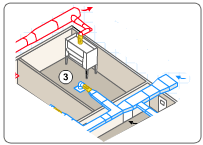|
 
Lab IntroductionIn this lab, the reason for the constant volume requirement is the presence of equipment that needs a constant exhaust rate, such as a biosafety cabinet. Because the volume of air required by the equipment will always be higher than both the ventilation rate and the cooling demand for the lab, this zone will always require the same constant volume. Sequence of OperationsIntroductionA conventional constant volume fume hood is designed to exhaust a volume of air which provides a face velocity of 100 fpm at the sash opening when the sash is fully open. As the sash opening decreases, the volume remains constant, thus increasing the face velocity. A bypass fume hood with an airflow grille that is uncovered as the sash is lowered is generally used to prevent excessive face velocities when the sash opening is reduced. In this application, a constant volume valve (CVV) is used to maintain a constant exhaust volume out of the fume hood as the static pressure in the exhaust duct system fluctuates. The hood exhaust valve is configured with a factory-mounted pressure switch to detect low static pressure across the valve. The fume hood is equipped with a constant volume fume hood monitor which generates an alarm to alert the operator to low static pressure conditions. The make-up air volume entering the zone is also controlled with a constant volume valve (CVV). This valve maintains a constant make-up air volume into the zone as the static pressure in the supply duct system fluctuates. The zone's thermal load is assumed to be low enough that the make-up air volume, having been sized to satisfy the ventilation rate (calculated from air changes per hour), also maintains space temperature. In addition, the make-up volume is sized so that, in conjunction with the fume hood exhaust volume, the desired net negative room offset volume is provided. By having a pressure independent valve on both the fume hood exhaust and make-up air sources, zone pressurization control is maintained. Independently, the zone thermostat controls the reheat coil to provide zone temperature control. Hood OperationWhen the fume hood sash is lowered, the bypass air grille shall be uncovered so that make-up air from the zone can be pulled into the top of the hood to satisfy the exhaust volume demand. As the fume hood sash is raised, the sash pane shall block the bypass grille opening, thereby forcing the make-up air to be pulled into the hood through the sash opening. Room PressurizationTo achieve a negative room offset volume, the CVV hood exhaust valve shall be factory pre-set to a volume at least 10% greater than that of the CVV make-up air valve. This shall result in a room offset volume that enters the pressurization zone from the corridor or adjacent spaces, thereby providing pressurization control of the zone. Static Pressure FluctuationsExhaust Pressure Fluctuations - As the static pressure in the exhaust duct system fluctuates, the pressure independent cone/spring assembly of the constant volume hood exhaust valve shall modulate to maintain a fixed volume out of the fume hood within one second. Supply Pressure Fluctuations - As the static pressure in the supply duct system fluctuates, the pressure independent cone/spring assembly of the constant volume make-up air valve shall also modulate to maintain a fixed volume of make-up air into the zone within one second. Low Static PressureWhen the differential static pressure across the hood exhaust valve drops below the valve's minimum operating differential static pressure, the differential pressure switch (mounted on the hood exhaust valve) shall open, causing the constant volume fume hood monitor (mounted on the fume hood) to generate an audible and visual flow alarm, indicating that the valve is outside of its control range. A mute button shall silence the audible portion of the alarm. When system conditions return to normal, all alarms shall automatically clear. Temperature ControlIndependently, the zone thermostat shall control the reheat coil. Fail-safe Condition Since constant volume valves require neither pneumatic air nor power, a fail-safe condition does not apply to the valves in this application. |
  |
||||||
| HOME | MARKETS | PRODUCTS | SERVICES | CASE STUDIES | INCENTIVES | ABOUT US | ||||||
|
||||||
| HOME | MARKETS | PRODUCTS | SERVICES | CASE STUDIES | INCENTIVES | ABOUT US | CONTACT US | SITE MAP ©2007 All rights reserved. Newmatic Engineering. Website by SR Designs. |
||||||
